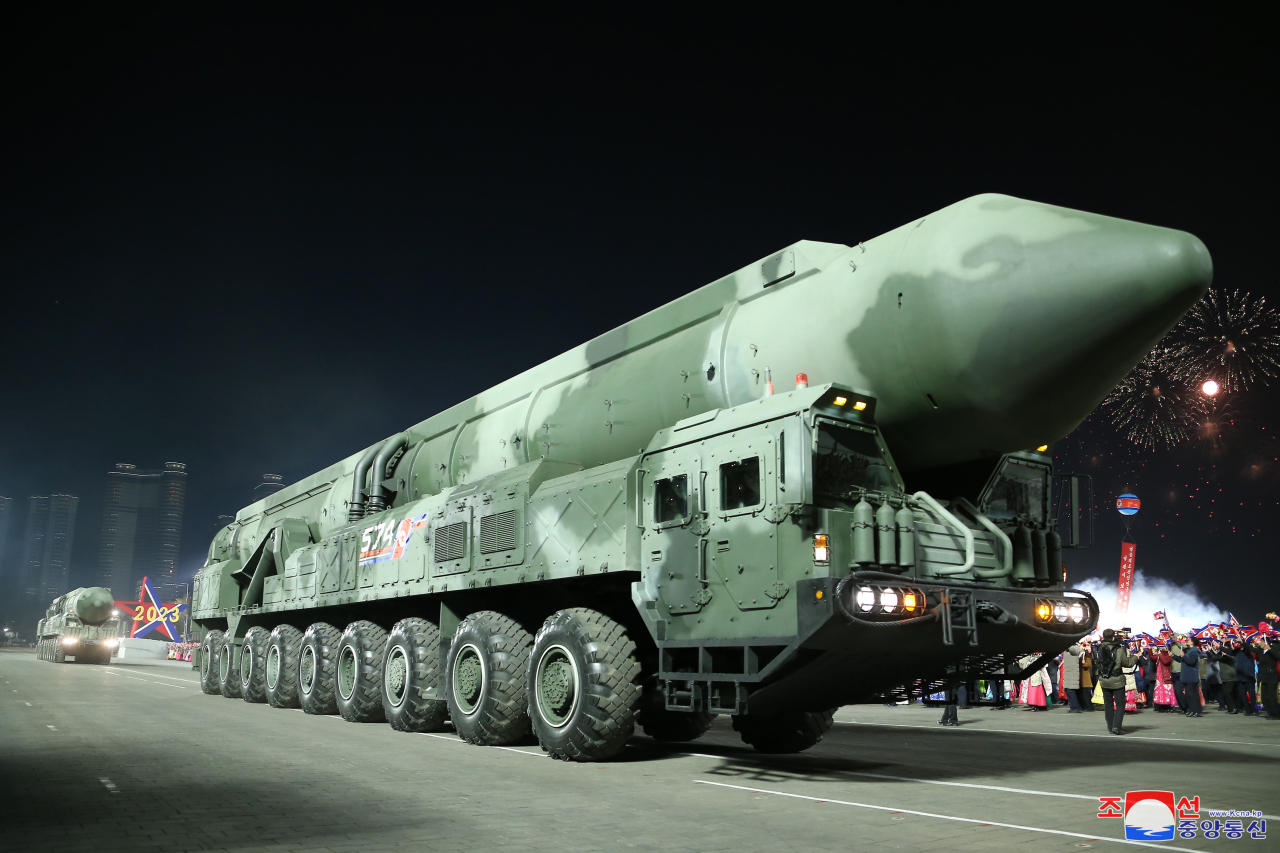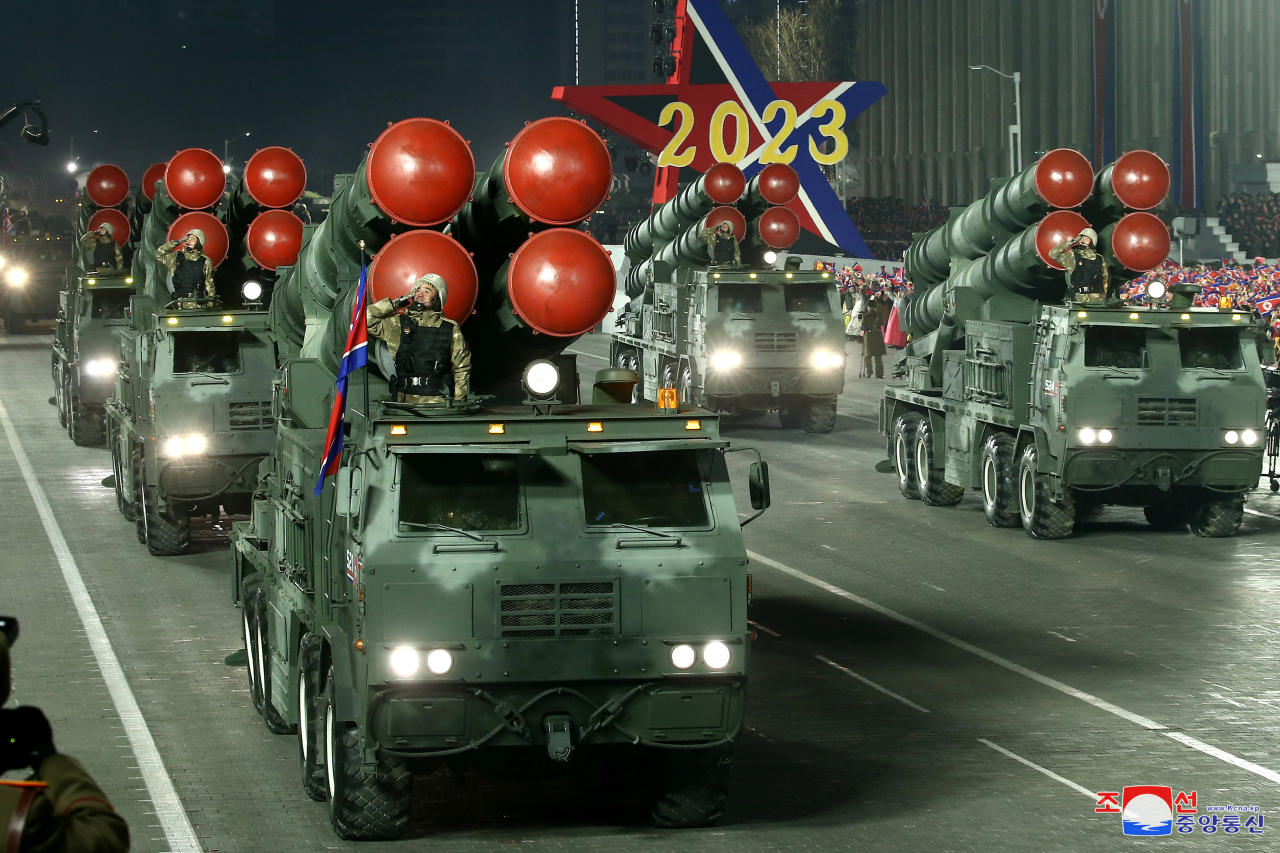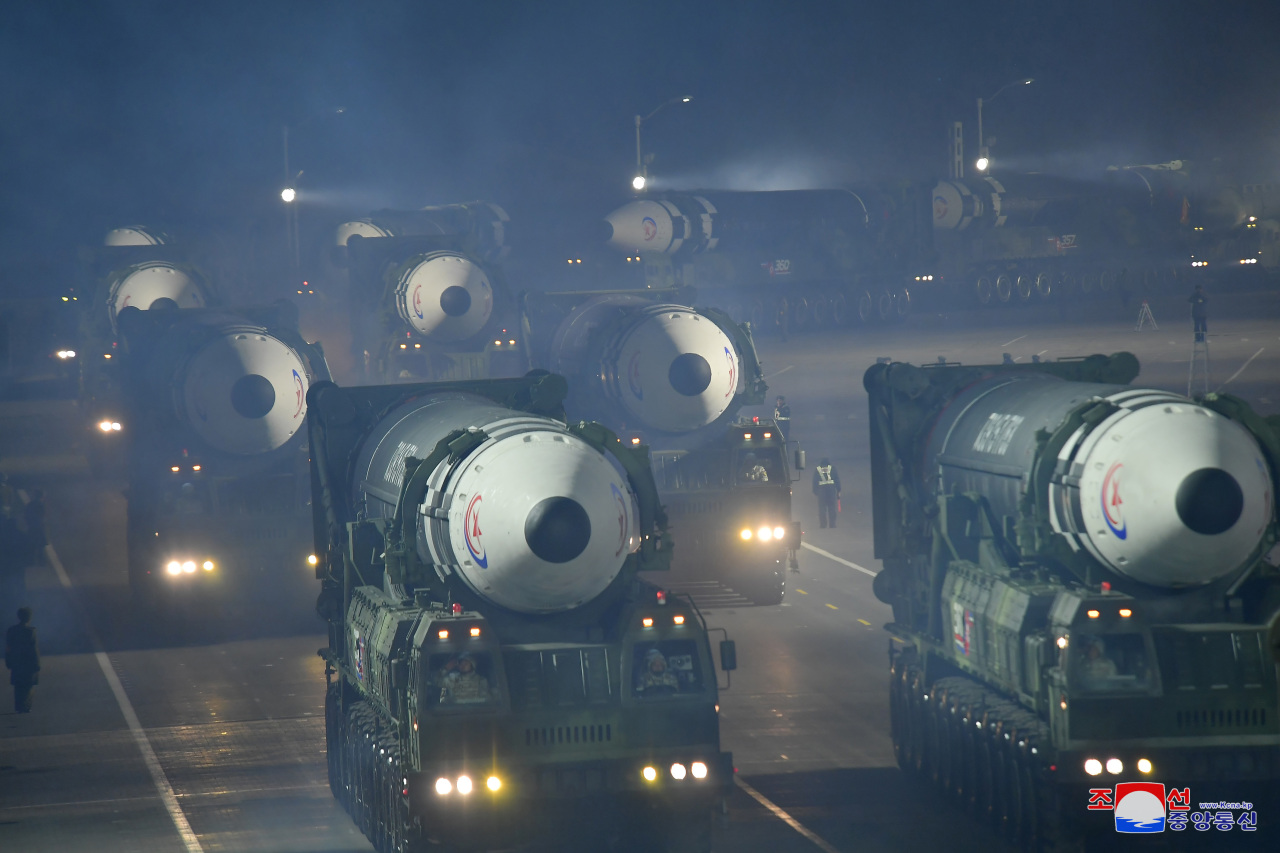 |
An apparent solid-fuel intercontinental ballistic missile, appears during a military parade at Kim Il Sung Square in Pyongyang on the night of Feb. 8, 2023, to mark the 75th founding anniversary of the Korea People's Army, in this photo released by the North's official Korean Central News Agency. North Korean leader Kim Jong-un attended the parade. (Yonhap) |
But the event, displaying the largest-ever number of nuclear-capable long-range missiles, clearly shows North Korea’s intent to relentlessly develop and mass-produce powerful strategic weapons that can hit the US mainland, according to experts after photos of the parade were released on Thursday.
North Korea staged a nighttime military parade on Wednesday attended by Kim to mark the 75th anniversary of the foundation of the Korean People’s Army that falls on Feb. 8, according to its state media.
Kim was clad in a black coat and black fedora that his grandfather and the country’s late founder Kim Il-sung used to wear as he watched the military parade from a balcony looking over the floodlit Kim Il Sung Square in Pyongyang with his daughter Ju-ae.
 |
North Korean leader Kim Jong-un (C) salutes during a military parade at Kim Il Sung Square in Pyongyang on the night of Feb. 8, 2023, to mark the 75th founding anniversary of the Korea People's Army, in this photo released by the North's Korean Central News Agency. (Yonhap) |
North Korean state media said “tactical nuclear operation units” rolled through the square by demonstrating the “powerful war deterrent and counterstrike ability.”
The imagery showed that the KN-23 solid-propellant short-range ballistic missile and the KN-25 “super large-caliber” multiple-rocket launcher -- which is widely believed to carry conventional and nuclear payloads -- were displayed, amid North Korea’s ongoing threat to strike South Korea with tactical nuclear weapons designed to be used on the battlefield.
 |
A photo released by the official North Korean Central News Agency (KCNA) shows KN-25 multiple rocket launcher systems displayed during a military parade at Kim Il Sung Square to mark the 75th anniversary of the founding of the Korean People's Army in Pyongyang, North Korea. (Yonhap) |
“ICBMs appeared in a trail at the parade square by showing off the epoch-making development of the DPRK’s national defense capability and our country’s greatest nuclear attack capabilities,” the Rodong Sinmun, an organ of the ruling Workers’ Party of Korea, said, referring to North Korea by the acronym for its official name, the Democratic People’s Republic of Korea.
North Korea previously showcased canisterized solid-fuel ICBMs at the military parade in April 2017, but this time has a different significance.
The transporter erector launchers, or TELs, carrying the canisters of the apparent new solid-propellant ICBMs have nine axles, while the TELs for the solid-fuel ICBM unveiled in 2017 have eight. The extra axle indicates that the carried missile is longer.
“They’ve previously paraded similar canisterized mock-ups except for their progress toward a solid-fuel ICBM is more credible now than it was in the past; the large-diameter engine test in December illustrates this,” Ankit Panda, a senior fellow in the nuclear program at the Carnegie Endowment for International Peace, told The Korea Herald.
The rollout of possible new solid-fuel ICBMs came months after North Korea tested what appears to be a new model of a new solid-fuel rocket engine at the Sohae Satellite Launching Station in December 2022.
The test of what North Korea labeled as the first-ever static firing testing of a “high-thrust solid-fuel motor with a thrust of 140 ton-force” was aimed at developing a new solid-fuel ICBM. Kim said he expected to see “another new-type strategic weapon within the shortest period of time” while guiding the testing.
“The reintroduction of a modified solid-fuel ICBM canister, after their recent large diameter solid-fuel missile motor test at Sohae, is an additional indication that they intend to diversify their long-range missile force,” David Schmerler, a senior research associate at the James Martin Center for Nonproliferation Studies, told The Korea Herald.
“These systems have an advantage over liquid-fueled ICBMs as they can be launched on shorter notice, increasing their survivability.”
The military parade offers a glimpse of North Korea’s missile development plans and strategies, according to experts.
“In regards to the new solid-fuel ICBM designs recently paraded, I want to stress that I don’t think these are real missile systems on parade – it’s more reflective of what North Korea is working on in comparison to the past,” Schmerler said.
Panda also pointed out that North Korea has a history of showcasing “large-diameter, untested solid-fuel missiles at several parades since 2020,” citing the Pukguksong-4 and Pukguksong-5 as examples.
But Kim Dong-yub, a professor at the University of North Korean Studies in Seoul, said North Korea could test-launch the new solid-fuel ICBM this year at the earliest in light of precedent cases.
“North Korea has a history of developing new weapons after displaying them at a military parade,” Kim said.
“North Korea will seek to make achievements by 2025 at the latest when the period of the 8th party congress ends,” he added, referring to the party meeting where the North Korean leader proposed the plan to develop solid-propellant ICBMs.
 |
The Hwasong-17 intercontinental ballistic missiles, appear during a military parade at Kim Il Sung Square in Pyongyang on the night of Feb. 8, 2023, to mark the 75th founding anniversary of the Korea People's Army, in this photo released by the North's official Korean Central News Agency. North Korean leader Kim Jong-un attended it. (Yonhap) |
“The North Koreans have enough ICBM launchers to significantly stress existing and planned US homeland missile defense capabilities. I do not think the United States can reliably count on its homeland being invulnerable to North Korean nuclear attack,” Panda said.
“US homeland missile defense was built to defend against a ‘limited’ missile threat from North Korea. That missile threat is no longer limited in size and will only continue to grow in the coming years.”
Professor Kim said the number of the Hwasong-17 displayed suggested that “North Korea has reached the stage of mass-producing and deploying the ICBMs.”
Yang Uk, a research fellow at the think tank Asan Institute for Policy Studies, said North Korea intended to “highlight its strategic strike capabilities” by showcasing the largest number of Hwasong-17 at the military parade to date. North Korea has displayed around six missiles of one type during previous parades.
“North Korea intends to send the message of strong warning to the US by mobilizing its ICBMs, including new solid-fuel ICBMs to the parade,” Yang said.
“But apart from that, there was nothing new and noteworthy at the military parade. I’d say ‘all booster, no payload.’ Despite North Korea’s chest-thumping, the military parade suggests challenges the country has faced in showcasing new weapons systems.”
The South Korean government on Thursday deplored that North Korea wasted resources for nuclear and missile developments and mobilized equipment for the military parade despite its aggravating food shortages and economic woes, the Ministry of Foreign Affairs said.
“The government will further step up overall efforts based on the audacious initiative to create an environment in which North Korea has no choice but to return to the dialogue table,” the ministry said, urging North Korea to immediately stop nuclear and missile developments and engage in denuclearization talks.




![[Exclusive] Hyundai Mobis eyes closer ties with BYD](http://res.heraldm.com/phpwas/restmb_idxmake.php?idx=644&simg=/content/image/2024/11/25/20241125050044_0.jpg)
![[Herald Review] 'Gangnam B-Side' combines social realism with masterful suspense, performance](http://res.heraldm.com/phpwas/restmb_idxmake.php?idx=644&simg=/content/image/2024/11/25/20241125050072_0.jpg)

